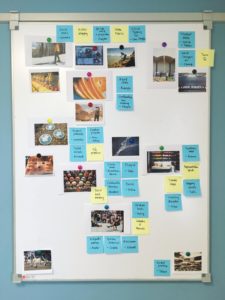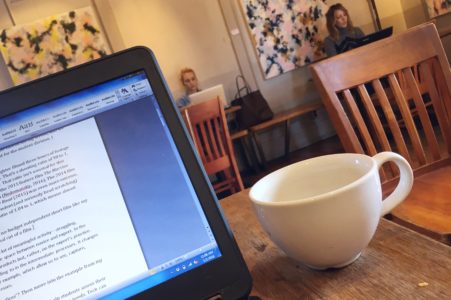Writing Life
 I really enjoy writing. You might not think that, given how infrequently I’ve been posting on this blog. That’s mostly because I’ve been producing a podcast, Leading Lines, that takes up most of my creative free time. But that’s also because I’ve been writing, just not for the blog. I finished the manuscript for my second book on May 1st, having spent a good chunk of the spring semester writing. And I really enjoy writing.
I really enjoy writing. You might not think that, given how infrequently I’ve been posting on this blog. That’s mostly because I’ve been producing a podcast, Leading Lines, that takes up most of my creative free time. But that’s also because I’ve been writing, just not for the blog. I finished the manuscript for my second book on May 1st, having spent a good chunk of the spring semester writing. And I really enjoy writing.
I wrote a proposal and draft chapter for the new book last summer, along with an detailed outline of the whole book. That’s my visual outline to the right, from last summer. I don’t have a title for the book yet, but I’m close to a subtitle: Using Technology to Support Student Learning. The goal of the book is to help college and university instructors make more informed, intentional choices about educational technology by mapping examples of creative and effective technology use to several key principles of learning. I wanted to take the stories and advice I share with faculty through workshops and consultations all the time and weave them together in a coherent package. I pitched the book to a publisher last fall. They were interested, so I signed a contract. (More details after their board gives final approval to the book!) I lined up a bunch of interviews with faculty across the country, to supplement the edtech examples I had already collected, and got to work.
During the fall, I tried blocking off a couple of hours every other day on my calendar to write, but that almost never worked. That time was always clobbered by my day job. Things changed when a colleague of mine mentioned her writing process to me at a campus event. She said that she goes on a two-day writing retreat each month. She clears her calendar, leaves campus, and writes solid for two days. That’s how she makes the time for her scholarly work. I thought that sounded smart, so I tried it this spring. It worked like a charm. I would actually spend the first half-day catching up on other work tasks, but by the afternoon I could reliably work on the book. And the second day was all writing. I could crank out four or five thousand words per retreat, when I really got going. I needed more than one a month, however, to meet my submission deadline. By April, I was spending more time writing than not. Luckily I wasn’t teaching this spring, and none of my other projects seemed to go off the rails, so I’ll call it a win.
 Finding a good space to write took some experimentation. I got married January 1 (yes, it was a busy year!), and my wife and I were a two house family for a few months. I found I couldn’t write at my house, since there were too many distractions, but I could write at her house. Coffee shops were great, too, particularly the Fainting Goat and Frothy Monkey. I would often spend the morning at a coffee shop and the afternoon at Emily’s house, working productively on my chapters. Then we bought a house together, and that became my home base for writing. Her kitchen table, our house with its great kitchen windows, all my stuff in boxes. I was crazy productive. By the end of April, I was writing so many words. It felt a little like my dissertation days, the first time I discovered how productive I could be on deadline!
Finding a good space to write took some experimentation. I got married January 1 (yes, it was a busy year!), and my wife and I were a two house family for a few months. I found I couldn’t write at my house, since there were too many distractions, but I could write at her house. Coffee shops were great, too, particularly the Fainting Goat and Frothy Monkey. I would often spend the morning at a coffee shop and the afternoon at Emily’s house, working productively on my chapters. Then we bought a house together, and that became my home base for writing. Her kitchen table, our house with its great kitchen windows, all my stuff in boxes. I was crazy productive. By the end of April, I was writing so many words. It felt a little like my dissertation days, the first time I discovered how productive I could be on deadline!
Tweeting helped, too. Some selections of my #writinglife tweets this spring:
- Checking the correct capitalization of hokey pokey.
#writinglife - Today’s word count brought to you by the Outlander soundtrack. @bearmccreary always makes for good writing music.
#writinglife - Watching a 15-sec ad before a YouTube video I want to see >> Figuring out how to access a journal article while at my home office.
#writinglife - I can’t write when I’m being watched. This apparently includes the dog. #writinglife
- I really have no experience typing rhinoceros. #writinglife
My Outlander phase only lasted a week. Then I found “Run Wild,” an up-tempo, folk-focused running mix on Spotify. I’m pretty sure a third of my book was written while listening to that playlist!
What really motivated me, however, was finding new ways to talk about ideas and practices I’ve made a part of my professional work for years. I have a chapter on using technology to make visible “thin slices” of student learning, to use a term from Georgetown’s Randy Bass. I heard him talk about this idea years ago at a conference, where he described video projects his students produced. He realized that a lot of what they learned was left on the cutting room floor. That is, their decisions what footage not to include were just as relevant to their learning as what they decided to include. I realized while writing that I had my own experience with this idea. Well, second-hand experience. My oldest daughter made a short film last year, and I asked her how much footage she shot. She filmed 90 minutes of raw footage for every minute that made it into the final cut. That gave me a story for the introduction to this chapter on formative assessment, and it was very satisfying to pull these threads together in 800 words or so.
I really enjoy writing.
I’m hoping to do more of it here on the blog. (It would be hard to do less!) But first, revisions. My manuscript was submitted back in May, then went out to reviewers. I just received their feedback last week, and I know it will help make a better book. I’ll be revising bits and pieces over the next month, so I’ve blocked out some more writing retreats on my calendar. I’m not sure if I’ll write at my house this time. Emily and I have done a lot to make it a home, so it might be a little too distracting.
There’s always Frothy Monkey.